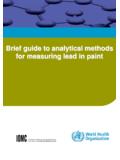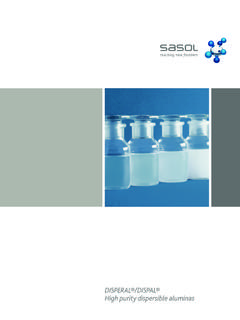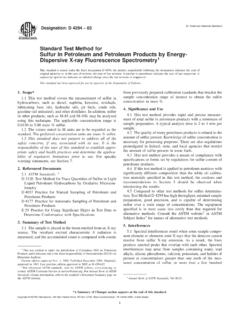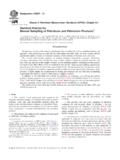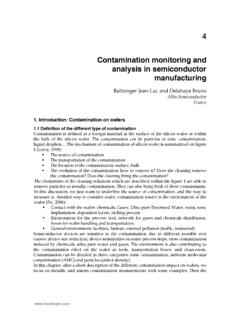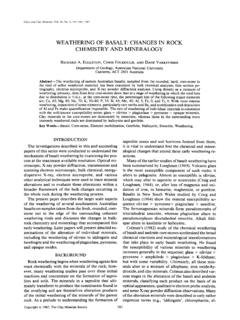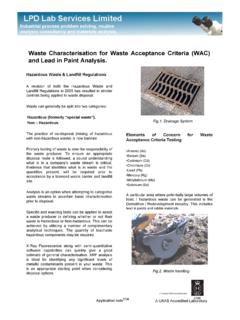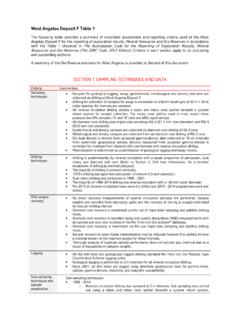Transcription of Method 6200: Field Portable X-Ray Fluorescence ...
1 6200 - 1 Revision 0 February 2007 Method 6200 Field Portable X-Ray Fluorescence SPECTROMETRY FOR THEDETERMINATION OF ELEMENTAL CONCENTRATIONS IN SOIL AND SEDIMENTSW-846 is not intended to be an analytical training manual. Therefore, methodprocedures are written based on the assumption that they will be performed by analysts who areformally trained in at least the basic principles of chemical analysis and in the use of the addition, SW-846 methods, with the exception of required Method use for the analysisof Method -defined parameters, are intended to be guidance methods which contain generalinformation on how to perform an analytical procedure or technique which a laboratory can useas a basic starting point for generating its own detailed Standard Operating Procedure (SOP),either for its own general use or for a specific project application.
2 The performance dataincluded in this Method are for guidance purposes only, and are not intended to be and mustnot be used as absolute QC acceptance criteria for purposes of laboratory SCOPE AND Method is applicable to the in situ and intrusive analysis of the 26 analyteslisted below for soil and sediment samples. Some common elements are not listed in thismethod because they are considered "light" elements that cannot be detected by Field portablex-ray Fluorescence (FPXRF). These light elements are: lithium, beryllium, sodium, magnesium,aluminum, silicon, and phosphorus. Most of the analytes listed below are of environmentalconcern, while a few others have interference effects or change the elemental composition ofthe matrix, affecting quantitation of the analytes of interest.
3 Generally elements of atomicnumber 16 or greater can be detected and quantitated by FPXRF. The following RCRA analytes have been determined by this Method :AnalytesCAS Registry (Sb)7440-36-0 Arsenic (As)7440-38-0 Barium (Ba)7440-39-3 Cadmium (Cd)7440-43-9 Chromium (Cr)7440-47-3 Cobalt (Co)7440-48-4 Copper (Cu)7440-50-8 Lead (Pb)7439-92-1 Mercury (Hg)7439-97-6 Nickel (Ni)7440-02-0 Selenium (Se)7782-49-2 Silver (Ag)7440-22-4 Thallium (Tl)7440-28-0 Tin (Sn)7440-31-5 AnalytesCAS Registry - 2 Revision 0 February 2007 Vanadium (V) 7440-62-2 Zinc (Zn) 7440-66-6In addition, the following non-RCRA analytes have been determined by this Method :AnalytesCAS Registry (Ca)7440-70-2 Iron (Fe)7439-89-6 Manganese (Mn)7439-96-5 Molybdenum (Mo)7439-93-7 Potassium (K)7440-09-7 Rubidium (Rb)7440-17-7 Strontium (Sr)7440-24-6 Thorium (Th)7440-29-1 Titanium (Ti)7440-32-6 Zirconium (Zr) Method is a screening Method to be used with confirmatory analysis usingother techniques ( , flame atomic absorption spectrometry (FLAA), graphite furnance atomicabsorption spectrometry (GFAA), inductively coupled plasma-atomic emission spectrometry,(ICP-AES), or inductively coupled plasma-mass spectrometry, (ICP-MS)).
4 This Method s mainstrength is that it is a rapid Field screening procedure. The Method 's lower limits of detection aretypically above the toxicity characteristic regulatory level for most RCRA analytes. However,when the obtainable values for precision, accuracy, and laboratory-established sensitivity of thismethod meet project-specific data quality objectives (DQOs), FPXRF is a fast, powerful, costeffective technology for site Method sensitivity or lower limit of detection depends on several factors,including the analyte of interest, the type of detector used, the type of excitation source, thestrength of the excitation source, count times used to irradiate the sample, physical matrixeffects, chemical matrix effects, and interelement spectral interferences.
5 Example lower limitsof detection for analytes of interest in environmental applications are shown in Table 1. Theselimits apply to a clean spiked matrix of quartz sand (silicon dioxide) free of interelement spectralinterferences using long (100 -600 second) count times. These sensitivity values are given forguidance only and may not always be achievable, since they will vary depending on the samplematrix, which instrument is used, and operating conditions. A discussion of performance-basedsensitivity is presented in Sec. should consult the disclaimer statement at the front of the manual and theinformation in Chapter Two for guidance on the intended flexibility in the choice of methods,apparatus, materials, reagents, and supplies, and on the responsibilities of the analyst fordemonstrating that the techniques employed are appropriate for the analytes of interest, in thematrix of interest, and at the levels of concern.
6 6200 - 3 Revision 0 February 2007In addition, analysts and data users are advised that, except where explicitly specified in aregulation, the use of SW-846 methods is not mandatory in response to Federal testingrequirements. The information contained in this Method is provided by EPA as guidance to beused by the analyst and the regulated community in making judgments necessary to generateresults that meet the data quality objectives for the intended of this Method is restricted to use by, or under supervision of, personnelappropriately experienced and trained in the use and operation of an XRF instrument. Eachanalyst must demonstrate the ability to generate acceptable results with this SUMMARY OF FPXRF technologies described in this Method use either sealed radioisotopesources or X-Ray tubes to irradiate samples with x-rays.
7 When a sample is irradiated with x-rays,the source x-rays may undergo either scattering or absorption by sample atoms. This latterprocess is known as the photoelectric effect. When an atom absorbs the source x-rays, theincident radiation dislodges electrons from the innermost shells of the atom, creating vacancies. The electron vacancies are filled by electrons cascading in from outer electron shells. Electronsin outer shells have higher energy states than inner shell electrons, and the outer shell electronsgive off energy as they cascade down into the inner shell vacancies. This rearrangement ofelectrons results in emission of x-rays characteristic of the given atom. The emission of x-rays,in this manner, is termed X-Ray electron shells are generally involved in emission of x-rays during FPXRF analysisof environmental samples.
8 The three electron shells include the K, L, and M shells. A typicalemission pattern, also called an emission spectrum, for a given metal has multiple intensitypeaks generated from the emission of K, L, or M shell electrons. The most commonlymeasured X-Ray emissions are from the K and L shells; only metals with an atomic numbergreater than 57 have measurable M shell characteristic X-Ray line is defined with the letter K, L, or M, which signifies whichshell had the original vacancy and by a subscript alpha ( ), beta ( ), or gamma ( ) etc., whichindicates the higher shell from which electrons fell to fill the vacancy and produce the X-Ray . Forexample, a K line is produced by a vacancy in the K shell filled by an L shell electron, whereasa K line is produced by a vacancy in the K shell filled by an M shell electron.
9 The K transitionis on average 6 to 7 times more probable than the K transition; therefore, the K line isapproximately 7 times more intense than the K line for a given element, making the K line thechoice for quantitation K lines for a given element are the most energetic lines and are the preferred lines foranalysis. For a given atom, the x-rays emitted from L transitions are always less energetic thanthose emitted from K transitions. Unlike the K lines, the main L emission lines (L and L ) for anelement are of nearly equal intensity. The choice of one or the other depends on whatinterfering element lines might be present. The L emission lines are useful for analysesinvolving elements of atomic number (Z) 58 (cerium) through 92 (uranium).
10 An X-Ray source can excite characteristic x-rays from an element only if the source energyis greater than the absorption edge energy for the particular line group of the element, that is,the K absorption edge, L absorption edge, or M absorption edge energy. The absorption edgeenergy is somewhat greater than the corresponding line energy. Actually, the K absorptionedge energy is approximately the sum of the K, L, and M line energies of the particular element,and the L absorption edge energy is approximately the sum of the L and M line energies. FPXRF is more sensitive to an element with an absorption edge energy close to but less than6200 - 4 Revision 0 February 2007the excitation energy of the source.










